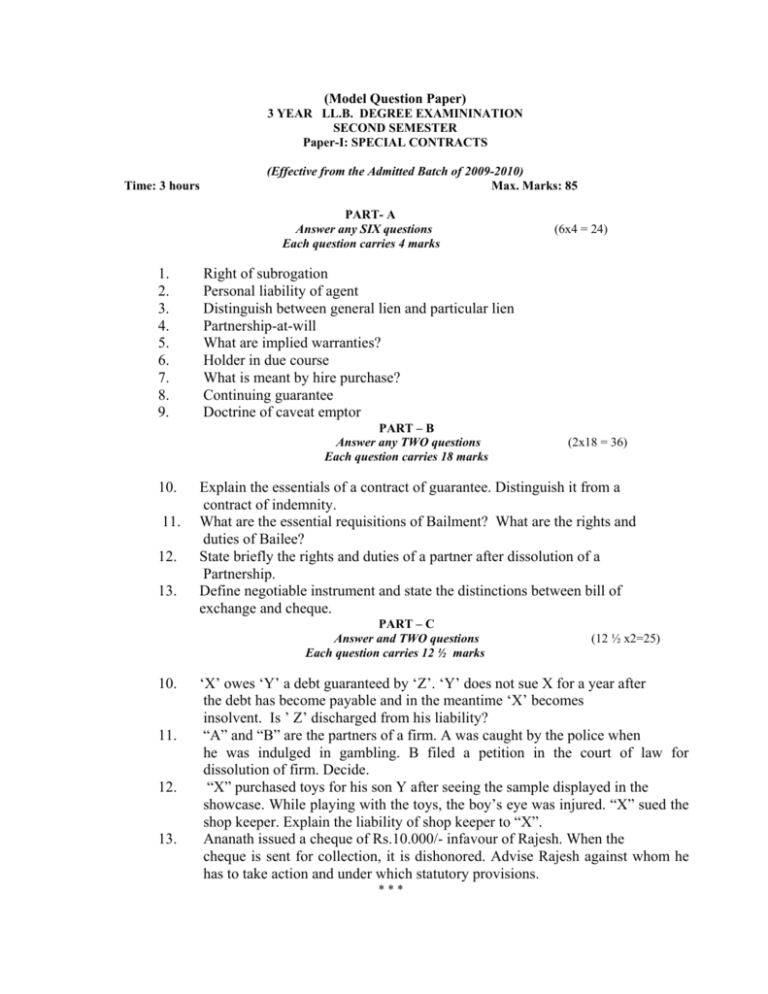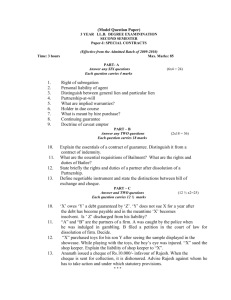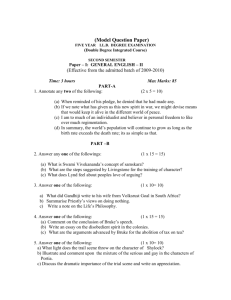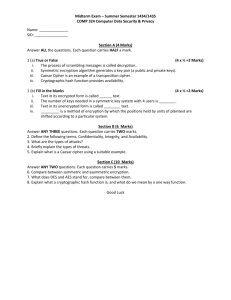Model Question Paper
advertisement

(Model Question Paper) 3 YEAR LL.B. DEGREE EXAMININATION SECOND SEMESTER Paper-I: SPECIAL CONTRACTS Time: 3 hours (Effective from the Admitted Batch of 2009-2010) Max. Marks: 85 PART- A Answer any SIX questions Each question carries 4 marks 1. 2. 3. 4. 5. 6. 7. 8. 9. Right of subrogation Personal liability of agent Distinguish between general lien and particular lien Partnership-at-will What are implied warranties? Holder in due course What is meant by hire purchase? Continuing guarantee Doctrine of caveat emptor PART – B Answer any TWO questions Each question carries 18 marks 10. 11. 12. 13. 11. 12. 13. (2x18 = 36) Explain the essentials of a contract of guarantee. Distinguish it from a contract of indemnity. What are the essential requisitions of Bailment? What are the rights and duties of Bailee? State briefly the rights and duties of a partner after dissolution of a Partnership. Define negotiable instrument and state the distinctions between bill of exchange and cheque. PART – C Answer and TWO questions Each question carries 12 ½ marks 10. (6x4 = 24) (12 ½ x2=25) ‘X’ owes ‘Y’ a debt guaranteed by ‘Z’. ‘Y’ does not sue X for a year after the debt has become payable and in the meantime ‘X’ becomes insolvent. Is ’ Z’ discharged from his liability? “A” and “B” are the partners of a firm. A was caught by the police when he was indulged in gambling. B filed a petition in the court of law for dissolution of firm. Decide. “X” purchased toys for his son Y after seeing the sample displayed in the showcase. While playing with the toys, the boy’s eye was injured. “X” sued the shop keeper. Explain the liability of shop keeper to “X”. Ananath issued a cheque of Rs.10.000/- infavour of Rajesh. When the cheque is sent for collection, it is dishonored. Advise Rajesh against whom he has to take action and under which statutory provisions. *** (Model Question Paper) 3 YEAR LL.B. DEGREE EXAMININATION SECOND SEMESTER Paper-II: CONSTITUTIONAL LAW - II (Effective from the Admitted Batch of 2009-2010) Time: 3 hours Max. Marks: 85 PART-A Answer any SIX questions Each question carries 4 marks (6x4 = 24) 1. Governor 2. Doctrine of pleasure 3. Financial emergency 4. Money Bill 5. Writ of Mandamus 6. Doctrine of pith and substance 7. Immunity of instrumentalities 8. Union List 9. Women Reservation Bill PART – B Answer any TWO questions Each question carries 18 marks (2x18 = 36) 10. Discuss the functions and jurisdiction of the Supreme Court of India 11. Explain the privileges and immunities of Parliament and its members. 12. What are the emergency provisions relating to the failure of the constitutional machinery in the states? 13. Explain the procedure to amend the constitution. Also explain importance basic structure doctrine in the amending the constitution. PART – C Answer and TWO questions (12 ½ x2=25) Each question carries 12 ½ marks 14. Ram Kumar. An employee of the Central government was dismissed from service, as he was proved guilty of committing a criminal offence. He was not given any prior notice of the impending removal. Decide the validity of the dismissal. 15. By means of an amendment to the constitution, the election disputes of the prime Minister and Speaker were kept beyond the scope of the courts and judicial scrutiny. Examine the validity of such amendment. 16. News paper “X” had printed some news which affects the reputation of local MLA. Can any action be taken against the News paper? 17. “X” a Bangladesh woman who came to India as part of a trade union delegation was brutally raped by railway employees at Calcutta railway station. The High Court granted a compensation of Rs. 5 lakhs to her on the ground that her right to personal liberty was violated by the rape. An appeal was filed by the Railway Board against the high Court decision before the Supreme Court. Decide. *** (Model Question Paper) 3 YEAR LL.B. DEGREE EXAMININATION SECOND SEMESTER Paper-III: ENVIRONMENTAL LAW INCLUDING LAWS FOR THE PROTECTION OF THE WILD LIFE AND OTHER LIVING CREATURES INCLUDING ANIMAL WELFARE (Effective from the Admitted Batch of 2009-2010) Time: 3 hours Max. Marks: 85 PART-A Answer any SIX questions (6x4 = 24) Each question carries 4 marks 1. 2. 3. 4. 5. 6. 7. 8. 9. RLEK case Public Trust Doctrine Kyoto protocol Noise pollution Kinds of pollution Hazardous waste management Biodiversity Act Green Courts Conservation of Forest PART – B Answer any TWO questions Each question carries 18 marks (2x18 = 36) 10. Explain various constitutional provisions concerning environmental protection. 11. What are the powers of the government to prevent environmental pollution under the Environmental protection Act, 1986? 12. Discuss the salient features of Reo Declaration 1992. 13. Mention various provisions to protect the wild life through Wild Life Protection Act. PART – C Answer and TWO questions Each question carries 12 ½ marks (12 ½ x2=25) 14. A glucose factory is causing air pollution by releasing fly ash and discharge of steam. This cumulatively caused inconvenience and discomfort to the people of that locality. But a complaint of public nuisance is made by a lady only as her husband is a heart patient. The factory management argued that it is not a public nuisance but only a private nuisance. – Advise. 15. Konkan Railways have undertaken a project to lay down a broad gauze railway line from Bombay to Kerala via Mangalore that is going to adversely affect the natural environment of that area. A public interest litigation was filed to that effect before the Supreme Court. Discuss the admissibility of the petition. 16. A state government after long time of declaration of a sanctuary, reduced the area from 765 sq.KM to 442 sq.KM on the ground of economic development of the State. Advise. 17. A notice was given to about 165 dyeing factories to close down the business as they are polluting water and discharging dirty water on the public roads thereby causing damage to public health. The petitioners claimed that they were doing business for the last 25 years and providing employment to 20,000 to 25,000 families and that the order is against Article 19(1)(g) also. Is the argument justifiable? *** (Model Question Paper) Time: 3 hours 3 YEAR LL.B. DEGREE EXAMININATION SECOND SEMESTER Paper-IV: JURISPRUDENCE (Legal Method, Indian Legal System and Basic Theory of Law) (Effective from the Admitted Batch of 2009-2010) Max. Marks: 85 PART-A Answer any SIX questions Each question carries 4 marks (6x4 = 24) 1. 2. 3. 4. 5. 6. 7. 8. Grund norm Transendental idealism Volksgeist Basic structure Ratio decidendi Sanctions Territorial nature of Law Immunity 9. Estoppel PART – B Answer any TWO questions Each question carries 18 marks (2x18 = 36) 10. “Courts put life into the dead letter of Law”. Explain. 11. Write an essay on “Custom” as a source of Law. 12. Define a “legal right”. Examine the correlation between a right and a duty. 13. Write an essay on “Liability”. PART – C Answer and TWO questions Each question carries 12 ½ marks (12 ½ x2=25) 14. Government of India has enacted a legislation where under the government is prohibited from establishing any industry and the legislation also provides total privatization of school education. Mr. X, wants to challenge the legislation as being unconstitutional. Advise him. 15. Government of India has impounded the passport of Mr. P under section 10 of the Indian Passports Act. Mr. P challenges the constitutional validity of the section 10 and the High Court of AP in the year 2007 has ruled that section10 is ultra vires of the constitution. The Supreme Court of India in the year 1998 has upheld the constitutional validity of section 10. Discuss the validity of the AP High Court judgment. 16. The State of A.P. has taken up the “Operation Storm” in order to comb out the Naxalites, members of a group that is declared to be an unlawful organization. In course of the operation, the special police deployed for this purpose, resort to looting the houses in villages. Can the State government be held liable for the acts of the special police? 17. State Government of A.P. provides heavy subsidy to pilgrims visiting Jerusalem, Mecca and Varanasi. A human rights organization wants to challenge this. On what grounds may this be challenged? *** (Model Question Paper) 3 YEAR LL.B. DEGREE EXAMININATION SECOND SEMESTER Paper-V: FAMILY LAW - II (Effective from the Admitted Batch of 2009-2010) Time: 3 hours Max. Marks: 85 PART-A Answer any SIX questions Each question carries 4 marks 1. 2. 3. 4. 5. 6. 7. 8. 9. Sapinda Codicil Per capita Rule of propinquity Residuary legacy Hires by consanquity Spes successions Privileged will Distant kindred PART – B Answer any TWO questions Each question carries 18 marks 10. 11. 12. 13. 15. 16. 17. (2x18 = 36) “Section 14 of Hindu Succession Act abolished limited estate.Do you agree ? Explain the doctrines of ‘AUL’ and ‘RADD’ with suitable illustrations. How the self acquired property of a male Christian died intestate will be distributed among his heirs? Examine the relevance of “Doctrine of notional partition” in the light of Hindu Succession (Amendment) Act, 2005. PART – C Answer and TWO questions Each question carries 12 ½ marks 14. (6x4 = 24) (12 ½ x2=25) A Hindu male residing at Vijayanagaram died on 2nd January, 2002 surviving his wife, three sons and two daughters of whom one was married in 1996. He left ancestral property worth Rs.4 lakhs and separate property worth Rs.6 lakhs. Divide the property among the heirs. X, a Mahomedan male governed by Shia law died surviving his wife, mother and one daughter. Determine their respective shares of the heirs. R dies intestate leaving behind his son who converted to Christianity, a daughter and father. Distribute R’s property in accordance with Hindu Succession Act. P constituted a joint family with his two sons Q and S. P inherits property worth Rs.150,00,00 from his uncle M. Q separates from P receiving his share of the joint family property while S remains with P. P then dies. Discuss fully the rights of Q and S in the property inherited by P from M. ***









